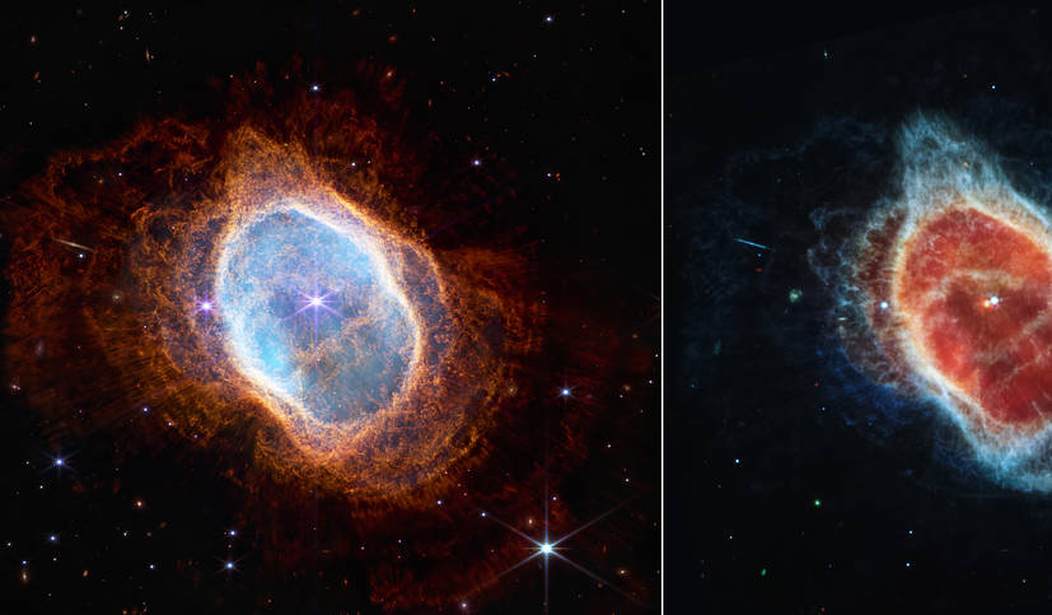Scientists may not be able to “know God’s thoughts” as Einstein suggested. But perhaps we can see the universe through His eyes.
The James Webb Space Telescope sent its first images back to earth on Tuesday, and whether you’re a scientific dunce like me or have earned a Ph.D. in astrophysics, the sheer beauty and grandeur contained in the images are a wonder to behold.
🌟 A star is born!
Behind the curtain of dust and gas in these “Cosmic Cliffs” are previously hidden baby stars, now uncovered by Webb. We know — this is a show-stopper. Just take a second to admire the Carina Nebula in all its glory: https://t.co/tlougFWg8B #UnfoldTheUniverse pic.twitter.com/OiIW2gRnYI
— NASA Webb Telescope (@NASAWebb) July 12, 2022
Being able to image these brand-new stars is almost miraculous. Webb can do it because it sees the universe in infrared light. Even the dimmest source of light is revealed in infrared.
Webb can also allow us to witness the death of stars. The star at the center of this nebula exploded thousands of years ago.
Bonus: Check out the Southern Ring Nebula as captured by @NASAHubble in 1998! pic.twitter.com/89y0hx5sUQ
— NASA Webb Telescope (@NASAWebb) July 12, 2022
The pic below is of Stephan’s Quintet, five galaxies in a beautiful and complicated gravitational dance.
✋🏼 Galactic high five!
In Webb’s image of Stephan’s Quintet, we see 5 galaxies, 4 of which interact. (The left galaxy is in the foreground!) Webb will revolutionize our knowledge of star formation & gas interactions in these galaxies: https://t.co/tlougFWg8B #UnfoldTheUniverse pic.twitter.com/b2kH1tSyMs
— NASA Webb Telescope (@NASAWebb) July 12, 2022
Webb’s mission is not specifically geared to finding life, but Webb has been able to detect water vapor on a distant exoplanet.
First look at the atmosphere of an interstellar planet called WASP-96b, 1,150 light-years away – with @NASAWebb, we can now tell it has abundant water: https://t.co/1qaZDQAbPm pic.twitter.com/OrP22r3hKG
— Chris Hadfield (@Cmdr_Hadfield) July 12, 2022
NASA’s James Webb Space Telescope has captured the distinct signature of water, along with evidence for clouds and haze, in the atmosphere surrounding a hot, puffy gas giant planet orbiting a distant Sun-like star.
The observation, which reveals the presence of specific gas molecules based on tiny decreases in the brightness of precise colors of light, is the most detailed of its kind to date, demonstrating Webb’s unprecedented ability to analyze atmospheres hundreds of light-years away.
While the Hubble Space Telescope has analyzed numerous exoplanet atmospheres over the past two decades, capturing the first clear detection of water in 2013, Webb’s immediate and more detailed observation marks a giant leap forward in the quest to characterize potentially habitable planets beyond Earth.
At $10 billion, the Webb space telescope is not a boondoggle, but many people will see it as a waste of money. It can never be a “boondoggle” because it will add several hundred libraries to the sum total of man’s knowledge of the universe and, perhaps, a glimpse at what his place in the cosmos might be.
But even many scientists believe that the $10 billion could have been spent on other worthy astronomical projects. History will judge whether the James Webb Space Telescope actually earned its keep.










Join the conversation as a VIP Member